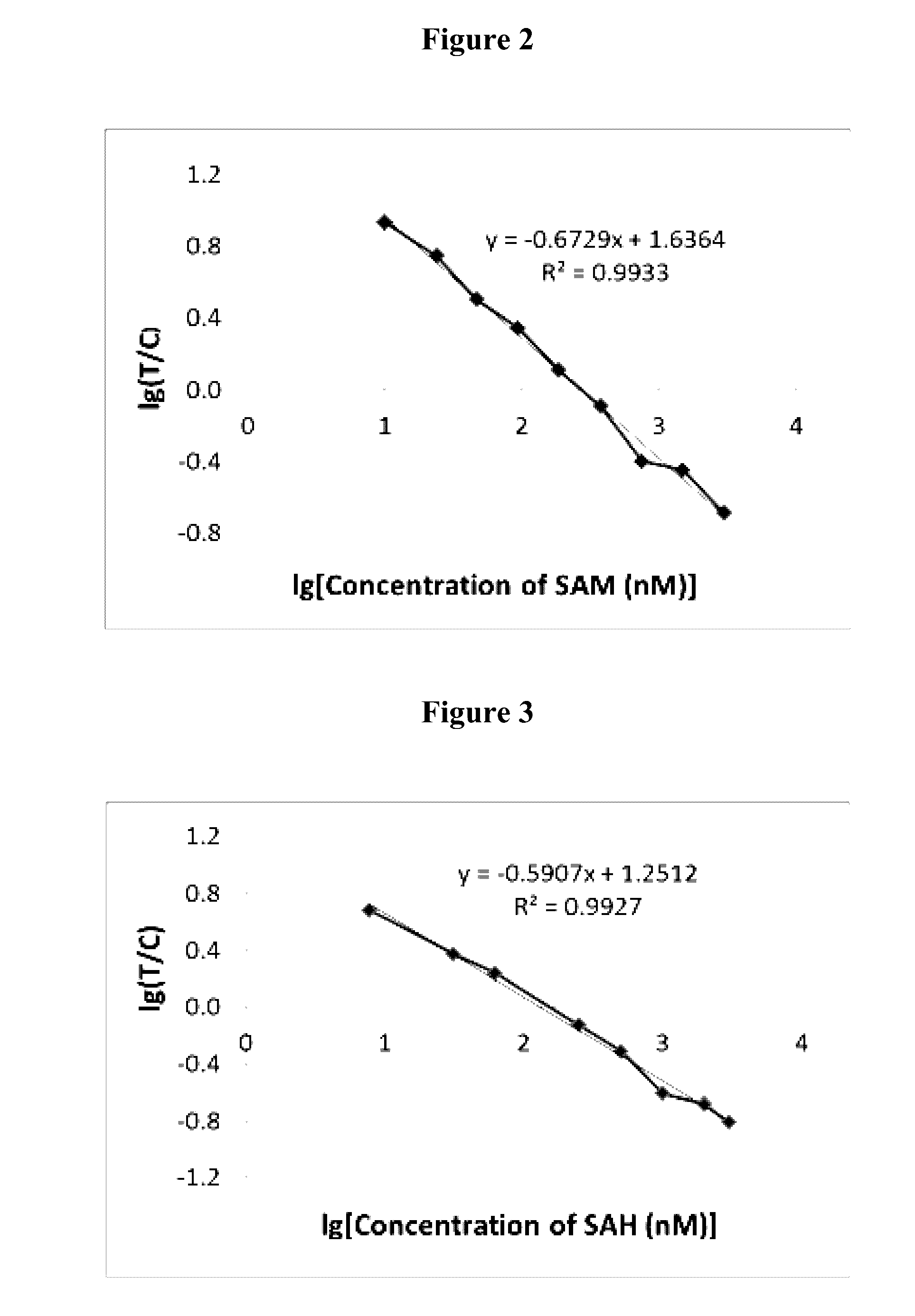Use of fluorescence for the quick and easy determination of s-adenosylmethionine, s-adenosylhomocysteine and homocysteine
a technology of s-adenosylmethionine and fluorescence, which is applied in the field of fluorescence for the quick and easy determination of s-adenosylmethionine, sadenosylhomocysteine and homocysteine, can solve the problems of limited absorption and emissivity capabilities numerous limitations of traditional organic dyes used to tag biological materials,
- Summary
- Abstract
- Description
- Claims
- Application Information
AI Technical Summary
Benefits of technology
Problems solved by technology
Method used
Image
Examples
example 1
SAM Quantitative Tests
Format 1: A Homogeneous Immunoassay for a Quick Quantification of SAM
[0108]Employ the homogeneous immunoassay such as Homogeneous Time-Resolved Fluorescence (HTRF® technology, as exemplified in our application Ser. No. 15 / 091,544 filed Apr. 5, 2016, the entire contents of which are incorporated by reference herein as if they were entirely denoted) and the competitive method to quantify SAM from samples by using anti-SAM monoclonal antibody and bio-conjugates (as exemplified in our application Ser. No. 15 / 091,544 filed Apr. 5, 2016, the entire contents of which are incorporated by reference herein as if they were entirely denoted.)
[0109](1) Use of the biotin, digoxigenin or digoxin conjugated SAM or SAM analogs as well as d2-conjugated SAM or SAM analogs with different lengths of linkers in the methods described in FIG. 8 on HTRF®
[0110]Rabbit anti-mouse IgG-XL665 and Europium (Eu3+) cryptate labeling kit were purchased from Cisbio Bioassays. Label mouse anti-dig...
example 2
SAH Quantitative Tests
Format 1: A Homogeneous Immunoassay for a Quick Quantification of SAH
[0118]Employ the homogeneous immunoassay such as Homogeneous Time-Resolved Fluorescence (HTRF® technology, as exemplified in our application Ser. No. 15 / 091,544 filed Apr. 5, 2016, the entire contents of which are incorporated by reference herein as if they were entirely denoted) and the competitive method to quantify SAH from samples by using anti-SAH monoclonal antibody and bio-conjugates (as exemplified in our application Ser. No. 15 / 091,544 filed Apr. 5, 2016, the entire contents of which are incorporated by reference herein as if they were entirely denoted.). The uses of the biotin, digoxigenin or digoxin conjugated SAH, d2-conjugated SAH with different lengths of linkers in HTRF®, and luciferase conjugated SAH in BRET with different lengths of linkers in the methods described in the FIG. 8 are similar to the procedures describe in the Example 1 Format 1 in this invention except for using...
example 3
MI Strip
A Fluorescent Immunochromatographic Test Strip for Measuring Methylation Index (MI)
[0121]Using the method of Example 1 as described above but BSA-SAM (or SAM analog) and BSA-SAH were applied to different areas of the NC membrane and dried. Both FT-anti-SAM and FT-anti-SAH were absorbed evenly to the glass fiber, and then assembled as shown in the FIG. 1B. The fluorescence intensity of the FT was measured separately, which will be converted into actual levels of SAM and SAH based on the preinstalled standard curves for the batch of strips. SAM and SAH test lines will display as two SAMe or different colors depending the type of FTs used to label the anti-SAM and anti-SAH antibodies. The strip allows measuring SAM and SAH at the SAMe time quickly and easily. MI is calculated and displayed on the Dry Immunofluorescence Analyzer.
PUM
| Property | Measurement | Unit |
|---|---|---|
| Time | aaaaa | aaaaa |
| Molar density | aaaaa | aaaaa |
| Molar density | aaaaa | aaaaa |
Abstract
Description
Claims
Application Information
 Login to View More
Login to View More - R&D
- Intellectual Property
- Life Sciences
- Materials
- Tech Scout
- Unparalleled Data Quality
- Higher Quality Content
- 60% Fewer Hallucinations
Browse by: Latest US Patents, China's latest patents, Technical Efficacy Thesaurus, Application Domain, Technology Topic, Popular Technical Reports.
© 2025 PatSnap. All rights reserved.Legal|Privacy policy|Modern Slavery Act Transparency Statement|Sitemap|About US| Contact US: help@patsnap.com



